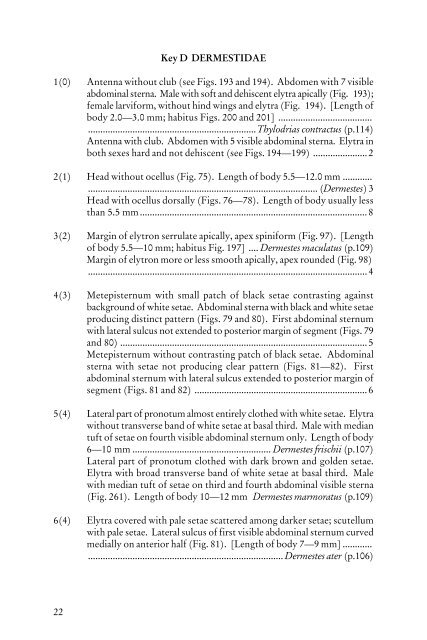Beetles Identification Guide
Beetles Identification Guide
Beetles Identification Guide
You also want an ePaper? Increase the reach of your titles
YUMPU automatically turns print PDFs into web optimized ePapers that Google loves.
22<br />
Key D DERMESTIDAE<br />
1(0) Antenna without club (see Figs. 193 and 194). Abdomen with 7 visible<br />
abdominal sterna. Male with soft and dehiscent elytra apically (Fig. 193);<br />
female larviform, without hind wings and elytra (Fig. 194). [Length of<br />
body 2.0—3.0 mm; habitus Figs. 200 and 201] ......................................<br />
....................................................................Thylodrias contractus (p.114)<br />
Antenna with club. Abdomen with 5 visible abdominal sterna. Elytra in<br />
both sexes hard and not dehiscent (see Figs. 194—199) ......................2<br />
2(1) Head without ocellus (Fig. 75). Length of body 5.5—12.0 mm ............<br />
............................................................................................. (Dermestes) 3<br />
Head with ocellus dorsally (Figs. 76—78). Length of body usually less<br />
than 5.5 mm ............................................................................................8<br />
3(2) Margin of elytron serrulate apically, apex spiniform (Fig. 97). [Length<br />
of body 5.5—10 mm; habitus Fig. 197] .... Dermestes maculatus (p.109)<br />
Margin of elytron more or less smooth apically, apex rounded (Fig. 98)<br />
.................................................................................................................4<br />
4(3) Metepisternum with small patch of black setae contrasting against<br />
background of white setae. Abdominal sterna with black and white setae<br />
producing distinct pattern (Figs. 79 and 80). First abdominal sternum<br />
with lateral sulcus not extended to posterior margin of segment (Figs. 79<br />
and 80) ....................................................................................................5<br />
Metepisternum without contrasting patch of black setae. Abdominal<br />
sterna with setae not producing clear pattern (Figs. 81—82). First<br />
abdominal sternum with lateral sulcus extended to posterior margin of<br />
segment (Figs. 81 and 82) ......................................................................6<br />
5(4) Lateral part of pronotum almost entirely clothed with white setae. Elytra<br />
without transverse band of white setae at basal third. Male with median<br />
tuft of setae on fourth visible abdominal sternum only. Length of body<br />
6—10 mm ........................................................ Dermestes frischii (p.107)<br />
Lateral part of pronotum clothed with dark brown and golden setae.<br />
Elytra with broad transverse band of white setae at basal third. Male<br />
with median tuft of setae on third and fourth abdominal visible sterna<br />
(Fig. 261). Length of body 10—12 mm Dermestes marmoratus (p.109)<br />
6(4) Elytra covered with pale setae scattered among darker setae; scutellum<br />
with pale setae. Lateral sulcus of first visible abdominal sternum curved<br />
medially on anterior half (Fig. 81). [Length of body 7—9 mm] ............<br />
............................................................................... Dermestes ater (p.106)
















